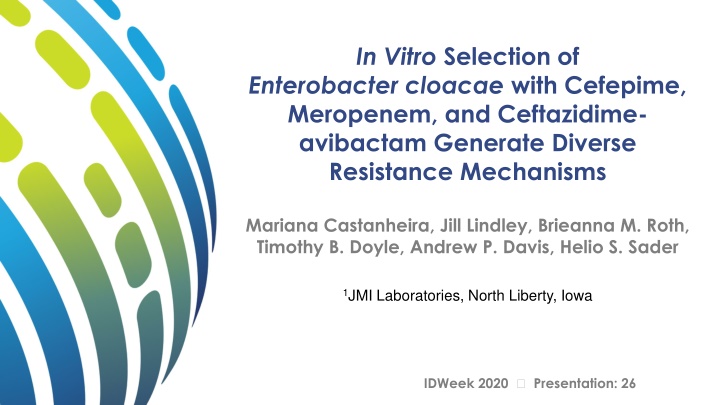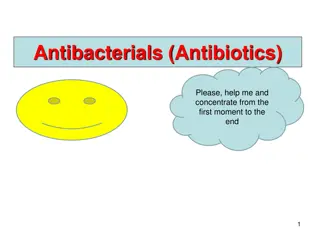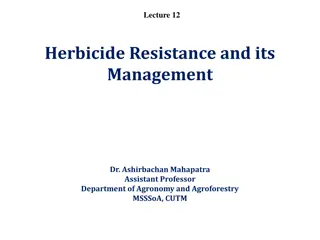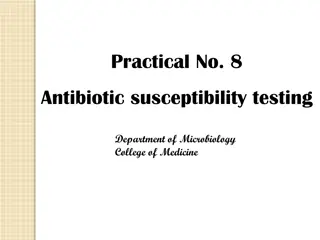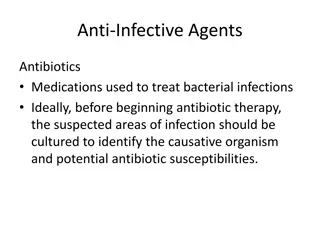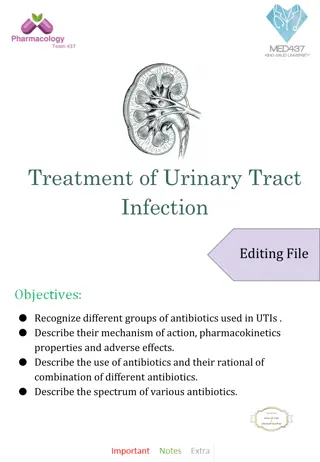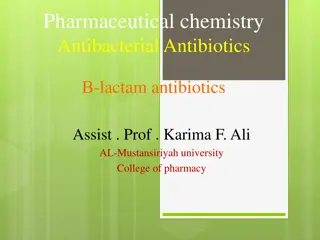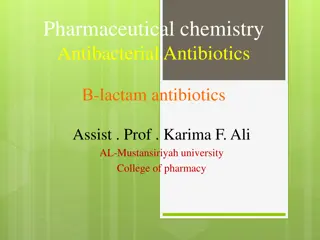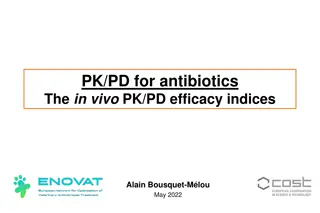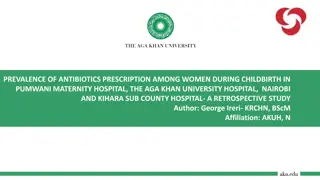In Vitro Selection of Enterobacter cloacae Resistance Mechanisms with Antibiotics
Study by Mariana Castanheira et al. presented at IDWeek 2020 discusses the generation of diverse resistance mechanisms in Enterobacter cloacae with cefepime, meropenem, and ceftazidime-avibactam. E. cloacae, a significant pathogen causing human infections, exhibits various resistance mechanisms, including overexpression of AmpC, outer membrane mutations, decreased permeability, and increased efflux. Treatment options for E. cloacae infections are limited due to resistance, leading to the use of cefepime and carbapenems. Ceftazidime-avibactam is a potential treatment option. Carbapenem-resistant E. cloacae strains are a concern.
Download Presentation

Please find below an Image/Link to download the presentation.
The content on the website is provided AS IS for your information and personal use only. It may not be sold, licensed, or shared on other websites without obtaining consent from the author.If you encounter any issues during the download, it is possible that the publisher has removed the file from their server.
You are allowed to download the files provided on this website for personal or commercial use, subject to the condition that they are used lawfully. All files are the property of their respective owners.
The content on the website is provided AS IS for your information and personal use only. It may not be sold, licensed, or shared on other websites without obtaining consent from the author.
E N D
Presentation Transcript
In Vitro Selection of Enterobacter cloacae with Cefepime, Meropenem, and Ceftazidime- avibactam Generate Diverse Resistance Mechanisms Mariana Castanheira, Jill Lindley, Brieanna M. Roth, Timothy B. Doyle, Andrew P. Davis, Helio S. Sader 1JMI Laboratories, North Liberty, Iowa IDWeek 2020 Presentation: 26
Disclosure Roivant Sciences Shionogi Spero Therapeutics Summit Pharmaceuticals Synlogic Taisho Pharmaceutical TenNor Therapeutics Tetraphase The Medicines Co. Theravance VenatoRX Vyome Therapeutics Wockhardt Yukon Pharmaceuticals Zai Lab Zavante Therapeutics Achaogen Allecra Allergan Amplyx Antabio Arietis Corp. Arixa Pharmaceuticals Astellas Pharma Athelas Basilea Bayer Boston Pharmaceuticals Cidara CorMedix DePuy Synthes Destiny Pharma Discuva Ltd. Dr. Falk Pharma GmbH Emery Pharma Entasis Therapeuticals Eurofarma Brasil Fox Chase Chemical Diversity Center, Inc. Gateway Pharmaceutical GenePOC Inc. Geom Therapeutics, Inc. GSK Harvard University Helperby HiMedia Laboratories F. Hoffmann-La Roche Janssen ICON plc Idorsia Pharmaceuticals Iterum Therapeutics Laboratory Specialists Melinta Therapeutics Merck Microchem Laboratory Micromyx MicuRx Pharmaceuticals Mutabilis Co. Nabriva Pocared PTC Therapeutics Rempex Novartis NAEJA-RGM Paratek Pfizer Polyphor Prokaryotics Inc Qpex Biopharma Ra Pharmaceuticals
E. cloacae Enterobacter cloacae causes a variety of human infections This organism was included in the ESKAPE pathogen list due to its ability to cause serious infections and develop resistance during treatment Acquired -lactamases are not the most common -lactam resistance mechanism in E. cloacae Davin-Regli et al., CMR, 2019 Boucher et al., CID, 2009 Davin-Regli et al., CMR, 2019
-lactam resistance in E. cloacae Important contributors to -lactam resistance, alone and in combination, are: Overexpression of the constitutive AmpC Outer membrane mutations decreasing -lactams permeability Increased efflux ESBLs and carbapenemases encoding resistance have been described in this species Davin-Regli et al., CMR, 2019
Treatment of E. cloacae infections Due to resistance to many -lactam agents, cefepime and carbapenems have been used for treatment of E. cloacae infections The increased use of carbapenems to treat infections caused by E. cloacae could have generated higher resistance levels in this species E. cloacae is the second most common carbapenem-resistant Enterobacterales (CRE; data from the SENTRY Program) Most CR-E. cloacae isolates do not produce carbapenemases Davin-Regli et al., CMR, 2019
Ceftazidime-avibactam Ceftazidime-avibactam is approved by the United States Food and Drug Administration (US FDA) and by the European Medicine Agency (EMA) Avibactam restores the activity of ceftazidime in the presence of Ambler class A (ESBLs and KPC), class C (AmpC), and some class D (OXAs) enzymes Complicated urinary tract infections, including pyelonephritis Complicated intrabdominal infections with metronidazole Hospital acquired pneumonia
Objective We subjected 6 E. cloacae isolates to 10-day serial passage with cefepime, meropenem, and ceftazidime-avibactam to evaluate resistance level and mechanism in the mutant strains
Methods Baseline and mutant isolates were susceptibility tested by reference broth microdilution (CLSI; M07, 2018) against cefepime, meropenem, and ceftazidime-avibactam (inhibitor at 4 mg/L) Serial passaging was performed in broth microdilution by inoculating the highest growth well from the broth microdilution panels into new panels Colonies growing in the highest antimicrobial concentrations were submitted to short-read whole genome sequencing (WGS) on a MiSeq (Illumina, San Diego, California, USA) and analyzed for - lactam resistance mechanisms -lactam resistance genes AmpC AmpR AmpD OmpC OmpF AcrA AcrB TolC MarA MarB MarR RamA RamR CsrA RobA SoxS CLSI M7Ed10, 2018
Methods Final mutants displaying >2-fold changes from the baseline and baseline isolates were sequenced using a long-read technology in a MinIOn (Nanopore, Oxford, UK) FASTQ files generated using short and long reads were combined and used for single nucleotide polymorphism (SNP) analysis SNPs determined by MAUVE independently and mapped using BWA Variant call format (VCF) file had minimum read depth of 4X, >30 map quality, >50 average base quality, no significant strand bias, and >75% of mutations within reads to support the presence of any given alteration Indels and uncovered regions were identified using nucDiff (https://omictools.com/nucdiff-tool)
Results MIC (mg/L) ECL Isolate Meropenem #1 0.03 #2 0.03 #3 0.03 #4 0.06 #5 0.06 #6 0.03 Ceftazidime- avibactam 0.5 0.25 0.25 0.5 0.5 0.25 Cefepime Resistance genes 0.5 act-18, aph(6)-Ia 0.25 act-17, fosA 0.5 act-41-like, aadA2, sul1 0.5 act-15-like, aph(6)-Ia 0.25 act-12-like, fosA 0.25 cmh-3-like, aph(6)-Ia, aph(6)-Id
ECL#2 Serial Passaging MICs ECL#1 Serial Passaging MICs 64 64 16 16 MIC (mg/L) MIC (mg/L) 4 4 1 1 0.25 0.25 0.0625 0.0625 0.015625 0.015625 1 2 3 4 5 6 7 8 9 10 1 2 3 4 5 6 7 8 9 10 Day Day Meropenem Cefepime Ceftazidime-avibactam Meropenem Cefepime Ceftazidime-avibactam ECL#3 Serial Passaging MICs 64 16 MIC (mg/L) 4 1 0.25 0.0625 0.015625 1 2 3 4 5 6 7 8 9 10 Day Meropenem Cefepime Ceftazidime-avibactam
ECL#5 Serial Passaging MICs ECL#4 Serial Passaging MICs 64 32 16 8 MIC (mg/L) MIC (mg/L) 4 2 1 0.5 0.25 0.125 0.0625 0.03125 0.015625 1 2 3 4 5 6 7 8 9 10 1 2 3 4 5 6 7 8 9 10 Day Day Meropenem Cefepime Ceftazidime-avibactam Meropenem Cefepime Ceftazidime-avibactam ECL#6 Serial Passaging MICs 64 16 MIC (mg/L) 4 1 0.25 0.0625 0.015625 1 2 3 4 5 6 7 8 9 10 Day Meropenem Cefepime Ceftazidime-avibactam
Fold change for Meropenem MIC results and E. cloacae isolates #1 #2 #3 1 1 1 1 1 1 2 2 2 2 4 2 2 4 2 8 4 4 8 4 16 16 4 16 32 4 16 32 8 16 Day 1 2 3 4 5 6 7 8 9 10 #4 1 4 4 16 32 32 64 128 128 128 #5 1 2 4 4 4 4 4 4 8 8 #6 1 1 2 4 4 8 8 16 32 64 Median 1 1 2 4 4 6 8 16 24 24 Mode 1 1 2 4 4 4 8 16 32 8 Geo Mean 1.0 1.4 2.5 4.0 4.5 7.1 10.1 14.3 20.2 25.4
Fold change for Ceftazidime-avibactam MIC results and E. cloacae isolates #1 #2 #3 1 1 1 2 2 1 2 2 1 2 2 1 2 4 1 4 4 2 8 4 2 8 4 2 32 8 2 32 8 2 Day 1 2 3 4 5 6 7 8 9 10 #4 1 2 2 2 4 4 4 8 16 8 #5 1 2 2 2 2 2 2 2 2 2 #6 1 1 2 2 2 2 2 2 2 2 Median 1 2 2 2 2 3 3 3 5 5 Mode 1 2 2 2 2 4 2 2 2 2 Geo Mean 1.0 1.6 1.8 1.8 2.2 2.8 3.2 3.6 5.7 5.0
Fold change for Cefepime MIC results and E. cloacae isolates #1 #2 #3 1 1 1 4 2 4 8 4 4 8 4 4 8 4 4 8 4 4 8 32 4 32 32 4 64 32 4 32 32 4 Day 1 2 3 4 5 6 7 8 9 10 #4 1 8 8 32 64 64 128 128 128 128 #5 1 2 2 8 8 16 16 16 16 16 #6 1 2 4 4 8 8 8 16 16 16 Median 1 3 4 6 8 8 12 24 24 24 Mode 1 2 4 4 8 8 8 32 16 32 Geo Mean 1.0 3.2 4.5 7.1 9.0 10.1 16.0 22.6 25.4 22.6
MIC Fold change for E. cloacae isolates Meropenem Geo Mean 1 1 1.4 2 2 2.5 4 4 4.0 4 4 4.5 6 4 7.1 8 8 10.1 16 16 14.3 24 32 20.2 24 8 25.4 Ceftazidime-avibactam Cefepime Geo Mean 2 2 1.6 2 2 1.8 2 2 1.8 2 2 2.2 3 4 2.8 3 2 3.2 3 2 3.6 5 2 5.7 5 2 5.0 Day 2 3 4 5 6 7 8 9 10 Median Mode Median Mode Median Mode 3 4 6 8 8 12 24 24 24 Geo Mean 3.2 4.5 7.1 9.0 10.1 16.0 22.6 25.4 22.6 2 4 4 8 8 8 32 16 32
SNP analysis CorC (CNNM family magnesium/cobalt transport protein) EnvZ (two-component system sensor histidine kinase) NlpE (envelope stress response activation lipoprotein) GalU (UTP-glucose-1-phosphate uridylyltransferase) multidrug efflux RND transporter permease subunit MioC (cell division inhibition FMN-binding protein) AmpC (chromossomal class C beta-lactamase) UrtB (urea ABC transporter permease subunit) sensor domain-containing phosphodiesterase ABC transporter substrate-binding protein TetR/AcrR-like (transcriptional regulator) RhlE (ATP-dependent RNA helicase) DNA-3-methyladenine glycosylase I glycosyltransferase family 4 protein hypothetical protein M942_13365 OmpC (outer membrane protein) UDP-glucose 6-dehydrogenase EAL domain-containing protein translation initiation factor IF-2 SlyA (transcriptional regulator) peptide chain release factor 1 hypothetical protein GtrA family protein beta-galactosidase chitoporin Isolate #1 Antimicrobial selection Meropenem (Day 10) Ceftazidime-avibactam (Day 10) Meropenem (Day 10) Ceftazidime-avibactam (Day 10) Cefepime (Day 6) Cefepime (Day 10) Meropenem (Day 10) Cefepime (Day 10) Meropenem (Day 10) Ceftazidime-avibactam (Day 10) Cefepime (Day 3) Cefepime (Day 10) Meropenem (Day 10) Cefepime (Day 10) Meropenem (Day 10) Cefepime (Day 10) missense stop upstream region alteration #2 #3 #4 #5 #6
Conclusions Meropenem (range 8 to 128-fold; median 24) and cefepime (4 to 128-fold; median 24) mutants had higher MIC values compared to ceftazidime- avibactam (range 2 to 32; media 5) Two isolates had multiple alterations in each of the sequenced mutants Mutations in the genes encoding AmpC, OmpC, and efflux regulators were observed in ceftazidime-avibactam and meropenem, meropenem and ceftazidime-avibactam, and cefepime mutants 3 of the 6 isolates had mutations in various genes that have not been described in relation to antimicrobial resistance and have roles in cell division, transcription regulation, RNA folding, and efflux
Conclusions This study suggests that exposure to cefepime and meropenem could generate isolates with elevated MIC values for these agents in 6 genetically distinct E. cloacae clinical isolates These high MICs were not observed with ceftazidime-avibactam Therapies that prevent the emergence of resistance could reduce the burden of antimicrobial resistance and should be part of stewardship efforts to control this problem
Acknowledgements This study was sponsored by Abbvie
